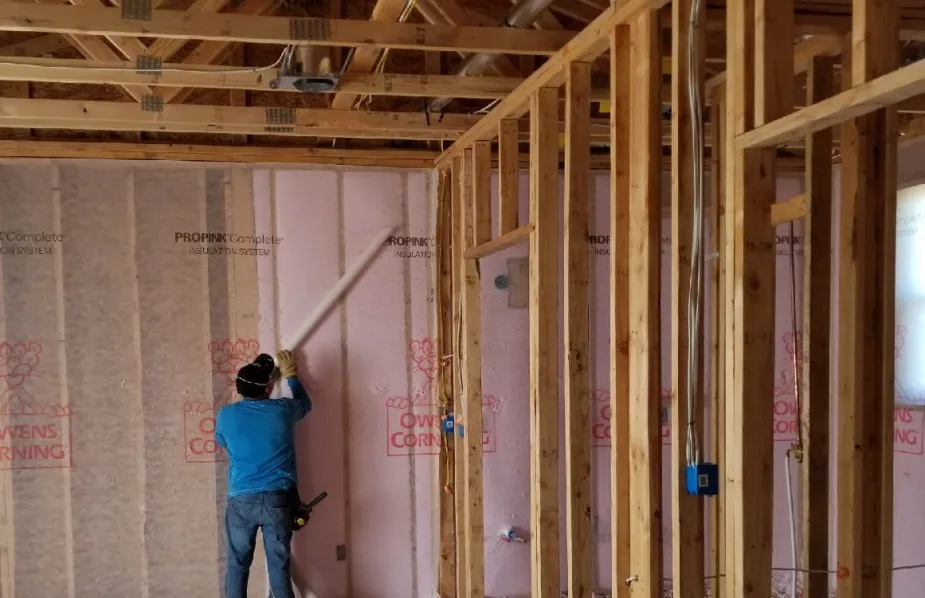Drill and Fill / Blown-In-Blanket-System

What Is Drill and Fill Insulation?
Many residential buildings, both old and new, are currently undergoing insulation retrofits to enhance energy efficiency and preserve conditioned air within the residence. Retrofitting involves a simple upgrade aimed at preventing warm air from escaping in winter and cooled air from escaping in summer, thereby creating energy efficiency through insulation.
Retrofit drill-and-fill offers the advantage of flexibility in installation, as it can be done from either the interior or exterior walls of the house. Opting for exterior installation may be particularly beneficial when internal access is not feasible. For many households, this insulation upgrade proves to be highly effective, thanks to enhanced R-Values that lead to significant year-round energy savings.
When it comes to insulating products, drill-and-fill retrofit is ideally suited for loose-fill insulation. This material is blown into the wall through pre-drilled holes, effortlessly conforming to the empty cavity area without compromising the wall’s integrity. This method offers the advantage of installation from either the inside or outside walls of the house, making it a versatile choice. In cases where interior access is restricted, completing the installation through the exterior walls can be particularly advantageous. For certain properties, this type of insulation upgrade represents an ideal solution, delivering improved R-Values that translate into substantial energy savings throughout the year.
Drill and Fill Insulation Process:
- Depending on your home, drilling will either be from the inside or the outside of the house.
- One- to two-inch diameter holes are drilled into each bay.
- One installer operates the hose to fill each hole while a second installer operates the blowing machine.
- The two installers use cellulose insulation to fill each bay of a wall providing maximum insulation.
- After all holes and bays are filled with cellulose insulation, each hole is patched up.
- This process can also be used to fill the space between floors, cutting down on sound transfer.

What Is Blown-In-Blanket-System (BIBS)?
Introducing a cutting-edge insulation technology, the “blow-in blanket system” utilizes specially crafted fiberglass blowing wool, which is applied to floors, walls, attics, or ceilings behind a mesh fabric. If you’re seeking superior R-Values and cost savings from your insulation, look no further. Studies reveal that even a small 4% empty area in improperly installed batt insulation can lead to a 50% increase in heat loss. The Blow-In-Blanket System, however, eliminates settling and voids, ensuring optimal insulation performance.
Only contractors approved by Blow-In Blanket are authorized to install this innovative system. When constructing a new building, the fiber is blown behind a specialized mesh fabric to create a seamless insulation layer. With the Blow-In-Blanket System, air gaps and costly voids are completely filled around pipes, wires, and other items within the cavity, providing comprehensive insulation coverage.
BIBS Insulation Benefits:
- Air Infiltration is lessened
According to national laboratory studies, the Blow-In-Blanket System offers greater comfort by reducing air infiltration by up to 68 percent in comparison to traditional batt-type insulation.
- Higher R-values for Efficiency
Higher R-values are produced by the Blow-In-Blanket System’s higher-density insulation, which helps you save money and energy.
- Outstanding Sound Control
The Blow-In-Blanket System provides exceptional sound management by entirely filling the space around any objects inside the wall cavity. For particular STC Ratings, please contact us.
- Non-Settling
It is guaranteed that the Blow-In-Blanket System won’t settle. Settling is eliminated by the novel technique of injecting the fiber behind a dust-free mesh.
- Safety
The Blow-In-Blanket System has no additional formaldehyde, is inherently non-flammable, and does not encourage the formation of mould.
- Recycled Materials
The Blow-In Blanket System uses fiberglass produced with at least 25% recycled material in addition to its energy-saving and custom-fitting features.
The Uses Are Endless! Blow-In-Blanket Can Be Used in:
- Retro-fit and new construction…both wood and steel frame
- Residential-Industrial-Commercial
- Metal Buildings
- Interior Sound Walls
- llergens and dust.
Services
Need a quote?
Contact us today for a FREE consultation on how to have an energy-efficient home


